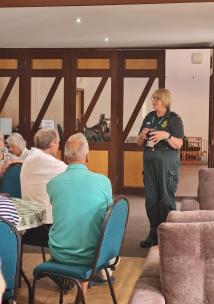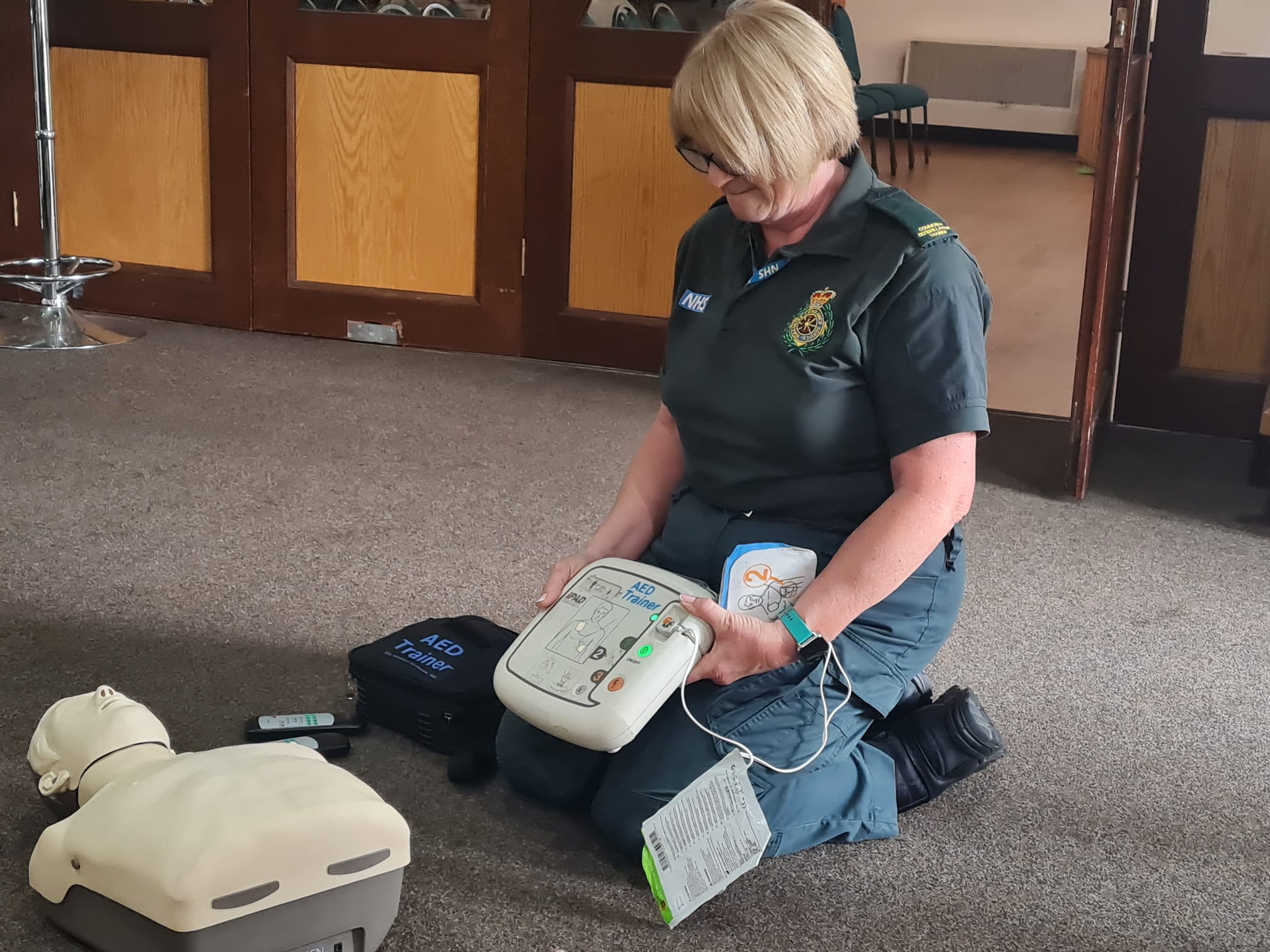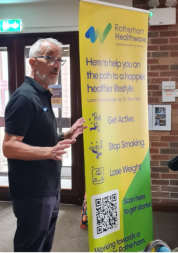Let's talk - CPR and defibrillators

Yvonne is a community defibrillation trainer for YAS and works across Rotherham, Barnsley and Doncaster.
Yvonne started by speaking to the group about how the ambulance service receives calls and how each call is categorised for a response. The categories she spoke about were:
- Category 1 - this can cover calls about things such as heart attacks, breathing difficulties, choking, drowning, heavy bleeding and anaphylactic episodes (severe allergic reactions).
- Category 2 - this can cover calls about things such as strokes if the person is being watched by someone else.
- Category 3/4/5 - these can cover calls about things such as suspected broken limbs and normally staff will keep you on the phone and talk you through helping the patient.
Yvonne went on to speak about how we often hear conversations in the community about there not being enough ambulances, but that this isn’t the case. There are enough ambulances but the public isn’t always aware of what else is going on. For example, ambulances may be queuing to deliver patients at hospitals but A&E may be full. In this instance, sometimes the ambulance staff wait in A&E with the patients so that the ambulance can go off to other emergencies.
CPR and defibrillators
Yvonne spoke to the group about the process to follow if someone has collapsed before potentially having to do CPR and/or use a defibrillator:
- Try and assess the whole situation first but quickly. Look at the surroundings, environment, think who might this person be - are you safe to approach, do they have a weapon etc and approach with caution.
- Check if the person is responsive. The method to do this can differ but you could give a gentle tap or speak loudly. A responsive person should respond to voice and touch.
- IF NOT RESPONDING - Call 999, as they are likely to be unconscious.
The ABC concept refers to the order of action in basic life support:
Airways - open the airways by tilting their head upwards by the chin.
Breathing - provide rescue breathing.
Circulation - perform chest compressions to restore the blood circulation (however there is no need to check for a pulse).
If they’re not breathing:
- 999 will talk you through CPR.
- They will ask if anyone is with you and if there is, they will be asked to go to collect the nearest defibrillator.
- 999 will provide a code so the defibrillator can be taken out of the box and taken to the person (the defibrillator could be up to 600 metres away).

When carrying out CPR:
- Place your hands, one on top of the other, in the middle of the person's chest.
- Pump down hard 30 times and then give the person 2 breaths.
- Repeat and keep going until the ambulance arrives.
Yvonne demonstrated the CPR technique to the group so that they could see how to do this in practice.
When using a defibrillator:
Yvonne went on to talk about defibrillators and showed the group that when using a defibrillator, there are clear instructions on it about how to use it.
She reassured them that they would also be on a call with 999 when using it as you cannot access a defibrillator without 999 giving you the code. Yvonne told the group how 999 will also talk you through the process on the call to help you and send an ambulance.
Yvonne advised that the best thing to do is to try to stay calm! The defibrillator’s job is to shock the heart but you can’t do any harm to the person by using it. Using CPR and a defibrillator together can help save lives. In fact, using a defibrillator gives an 85% chance of survival.
Yvonne spoke to the group about how people are sometimes afraid of doing CPR for fear of causing more damage. However, she reassured them that if they are faced with a person in cardiac arrest, that person is virtually dead, so there is no need to worry that you’re making the situation worse, you can only potentially make things better and save someone’s life.

The group asked Yvonne some questions about CPR:
Question - Is the same process done for someone with a pacemaker fitted?
Answer - Yes, as clearly the pacemaker isn’t working.
Question - How do you know when to stop doing CPR?
Answer - You don’t stop. Keep doing CPR until the ambulance arrives and keep the defibrillator equipment on the person (the pads etc)
Question - Do you check the pulse?
Answer - No, there is no need to check the pulse. This is something people used to be trained to do, but not anymore.
More information and guidance about CPR can be found on the Yorkshire Ambulance Service website:
https://restartaheart.yas.nhs.uk/get-involved/cpr-training-resources/
The talk was a great success and lots was learnt! A massive thank you to Yvonne for providing lots of useful information and helpful demonstrations, and to the Rotherham Heart Support group for hosting the session.
Do you know where your local defibrillators are located?
This website will tell you where to find ones closest to you (but this should not be used in an emergency, you should call 999 and they will tell you where you can access the nearest one) https://www.defibfinder.uk/
Let us know here at Healthwatch Rotherham if you think your area is lacking in this vital emergency equipment. Email us at info@healthwatchrotherham.org.uk
You can also read our report on Defibrillators in Rotherham here: https://healthwatchrotherham.org.uk/report/2022-09-22/defibrillators-rotherham-project

To find out more about the Yorkshire Ambulance Service, you can visit their website: https://www.yas.nhs.uk/
More information about the Rotherham Heart Support group can be found here: https://www.bhf.org.uk/what-we-do/find-bhf-near-you/rotherham-heart-support-group

